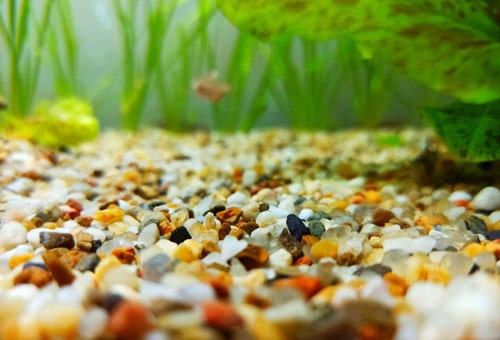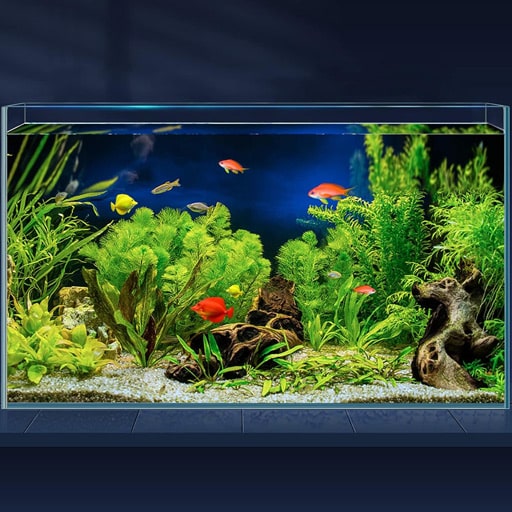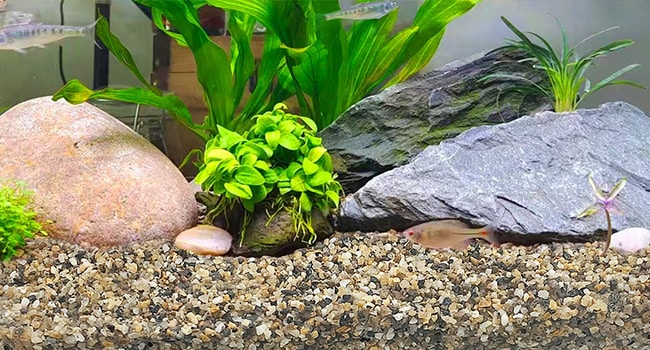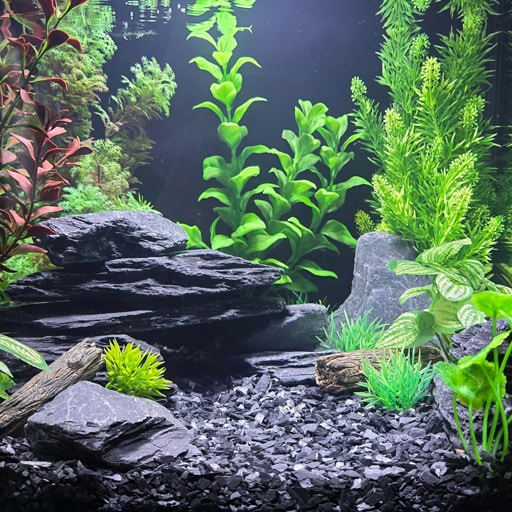Welcome to FishTankFAQ.com, I love to share beginner-friendly tips to make fishkeeping a breeze. One of the important lessons I learned was figuring out how much aquarium gravel I needed. This can feel a little tricky. My first time I overbought for my first 10-gallon tank and ended up with a messy pile! Gravel adds beauty, anchors plants, and supports filtration, but getting the right amount is key. In this guide, I’ll explain why gravel matters, how to calculate the perfect amount, the best types for beginners, and setup tips to keep your tank thriving. Let’s get your tank looking great!
Some links are affiliate links, meaning I may earn a commission at no cost to you. See my Affiliate Disclosure for details.

Why Aquarium Gravel Matters
Gravel (or substrate) enhances your tank’s aesthetics, provides a surface for beneficial bacteria, and anchors plants for a natural look. It impacts water quality and fish health:
- Aesthetics: Creates a vibrant backdrop for fish like bettas or guppies.
- Filtration: Hosts bacteria to break down waste, supporting filters like AquaClear 30 (around $45).
- Plant Support: Holds roots for plants like Java Fern.
Too much gravel traps debris, clouding water; too little looks sparse and limits plants. Getting it right, as I learned after a cloudy tank mishap, ensures a healthy setup. Learn more in Starting a Fish Tank for Beginners.
How Much Gravel Do You Need?
The amount of gravel depends on tank size and desired depth. Here’s a beginner-friendly rule of thumb, based on my experience:
- Standard Depth (1–2 inches): 1–2 lbs per gallon (e.g., 10–20 lbs for a 10-gallon tank).
- Shallow Depth (0.5–1 inch): 0.5–1 lb per gallon (e.g., 5–10 lbs for a 10-gallon tank).
- Tanks with live plants: Add 0.5 lb/gallon for deeper rooting areas (2–3 inches).
Calculations:
- 5-Gallon: 5–10 lbs (standard) or 2.5–5 lbs (shallow).
- 10-Gallon: 10–20 lbs (standard) or 5–10 lbs (shallow).
- 20-Gallon: 20–40 lbs (standard) or 10–20 lbs (shallow).
I am and have been a fan of CaribSea Super Naturals Gravel (Starting around$12 for 10 lbs) for affordability. Test water with API Master Test Kit (Around $35) to ensure clarity after adding gravel; see How to Make Fish Tank Water Clear.

Types of Aquarium Substrates
Beginners can choose from three main substrate types, each with pros and cons:
- Gravel: Coarse, natural look. Example: CaribSea Super Naturals ( around $15).
- Pros: Affordable, easy to clean, supports plants.
- Cons: Traps debris if too deep; rinse thoroughly.
- Sand: Fine, sleek aesthetic. Example: CaribSea Arag-Alive Sand ( around $25).
- Pros: Smooth look, good for some plants.
- Cons: Clouds water if not rinsed; harder to clean.
- Planted Substrates: Nutrient-rich for plants. Example: Fluval Plant and Shrimp Stratum ( around $25).
- Pros: Boosts plant growth, ideal for aquascaping.
- Cons: Expensive, can cloud water initially.
Gravel is best for most beginners due to cost and ease. See Can Aquarium Plants Grow in Sand [internal link] for sand-specific tips.
Comparison of Gravel Needs
This table includes affiliate links; see my Affiliate Disclosure for details.
| Tank Size | Standard Depth (1–2 inches) | Shallow Depth (0.5–1 inch) | Planted Depth (2–3 inches) | Gravel ideas | Approx Cost | Pros | Cons |
|---|---|---|---|---|---|---|---|
| 5-Gallon | 5–10 lbs | 2.5–5 lbs | 7.5–12.5 lbs | CaribSea Super Naturals on Amazon | $15/10 lbs | Affordable, easy to clean | Traps debris if too deep |
| 10-Gallon | 10–20 lbs | 5–10 lbs | 15–25 lbs | CaribSea Super Naturals on Amazon | $15/10 lbs | Stable, supports plants | Needs thorough rinsing |
| 20-Gallon | 20–40 lbs | 10–20 lbs | 30–50 lbs | Fluval Plant and Shrimp Stratum on Amazon | $20/4.4 lbs | Plant-friendly, aesthetic | Expensive, clouds initially |
| 20-Gallon Long | 20–40 lbs | 10–20 lbs | 30–50 lbs | Fluval Plant and Shrimp Stratum on Amazon | $20/4.4 lbs | Wide footprint, aquascaping-friendly | High cost for large amounts |

Choosing the Right Gravel
Select gravel based on your tank and goals:
- Grain Size: 1–2 mm for plants; 3–5 mm for aesthetics. Avoid fine sand unless you’re experienced. It can be kind of difficult to take care of.
- Color: Natural (e.g., CaribSea Moonlight Sand) or vibrant (e.g., CaribSea Gemstone Creek) for visual appeal.
- Tank Type: Neutral gravel for freshwater; avoid limestone for low pH tanks. Test with API Master Test Kit. Check out my post on How to Bring Aquarium pH Down.
- Budget: Gravel ($15/10 lbs) is cheapest; planted substrates ($20/4.4 lbs) cost more.
Tip: Start with CaribSea gravel for affordability and ease in 5–20-gallon tanks.
Setup and Maintenance
Proper gravel setup and maintenance keep your tank clear and healthy:
- Setup:
- Rinse gravel thoroughly in a bucket until water runs clear to avoid cloudiness.
- Layer 1–2 inches (or 2–3 inches for plants) evenly across the tank bottom.
- Add plants like Java Fern with Seachem Flourish Glue.
- Maintenance:
- Vacuum weekly with something like the Aqueon Siphon Vacuum, you can pick one up for about $10. They’re perfect for use during water changes. Check out my post on How to Make Fish Tank Water Clear.
- Stir gravel monthly to prevent debris buildup.
- Test water weekly with a test kit. See my post on how to monitor pH and ammonia.
- Troubleshooting: If water clouds, use Seachem Clarity (about $19) and then check your filter. I have a post on the Best Aquarium Filters.
Common Mistakes to Avoid
- Unrinsed Gravel: Clouds water; rinse until clear. See How to Make Fish Tank Water Clear.
- Too Much Gravel: Traps waste; stick to 1–2 lbs/gallon.
- Wrong Substrate: Limestone raises pH.
- No Plants: Misses nutrient absorption
- Overfeeding
FAQs
Here are answers to common gravel-related questions, that may help you out a little bit:
Q: How much gravel do I need for a 10-gallon tank?
A: For a 10-gallon tank, use 10–20 lbs of CaribSea Super Naturals for 1–2 inches depth, or 5–10 lbs for 0.5–1 inch. For plants, add 5 lbs for 2–3 inches in rooting areas. Rinse thoroughly to avoid cloudiness; see How to Make Fish Tank Water Clear.
Q: Can I use sand instead of gravel?
A: Yes, CaribSea Arag-Alive Sand works for a sleek look, needing 0.5–1 lb/gallon (5–10 lbs for 10 gallons). Rinse well to prevent cloudiness. It’s harder to clean than gravel but suits some plants. Use a siphon vacuum for cleaning maintenance.
Q: How much gravel do I need for a planted tank?
A: For tanks with live plants, use Fluval Plant and Shrimp Stratum at 1.5–2 lbs/gallon (15–25 lbs for 10 gallons) for 2–3 inches depth. Add Seachem Flourish for nutrients. Slope deeper at the back for rooting plants like Amazon sword.
Q: Will gravel affect my tank’s pH?
A: Neutral gravel like CaribSea Super Naturals won’t affect pH, but limestone or coral raises it. Test water and adjust with API pH Down solution if needed.
Q: How do I clean gravel in my tank?
A: Vacuum weekly with Aqueon Siphon Vacuum ( about $10) during 25% water changes. Stir gently to lift debris without disturbing plants. If cloudy, use Seachem Clarity. See What Are the Best Aquarium Filters for filtration.
Q: Can I mix gravel and sand in my tank?
A: Yes, mix CaribSea Super Naturals (about $15) with sand for a layered look, using 0.5–1 lb/gallon each (e.g., 5–10 lbs total for 10 gallons). Rinse both separately to avoid cloudiness. Sand may settle; vacuum carefully.
Q: How do I prevent gravel from clouding my tank?
A: Rinse gravel like CaribSea Super Naturals until water is clear before adding. Use Seachem Clarity ( about $10) if cloudiness occurs. Pair with AquaClear 30 for filtration and test with high quality test kit.
Get Started Today
We’ve come to the end of this post on how much aquarium gravel do I need, I hope your questions have been answered. Now, I recommend CaribSea Super Naturals for its affordability and ease in 5–20-gallon tanks. Calculate 1–2 lbs/gallon, rinse thoroughly, and test water regularly to keep your tank clear. Got questions? Drop them in the box down below or send me a message on the contact page.
- How Much Aquarium Gravel Do I Need for a Beginner Tank? - October 13, 2025
- Best Aquarium Testing Kit: A Complete Guide - September 27, 2025
- What Are the Best Aquarium Filters? - July 8, 2025

